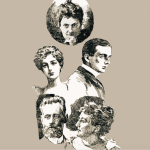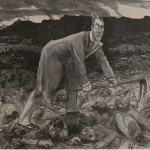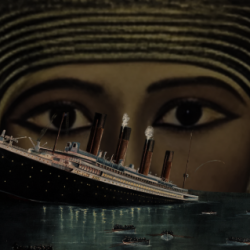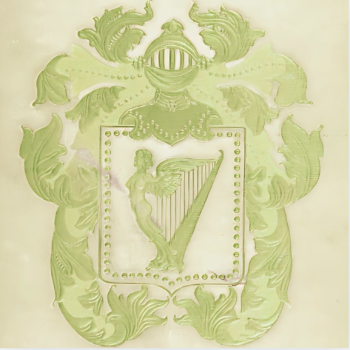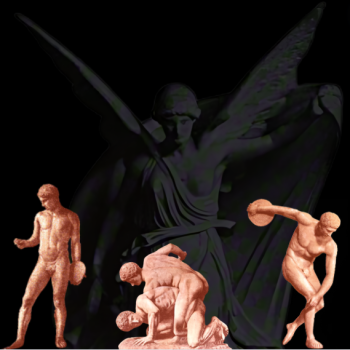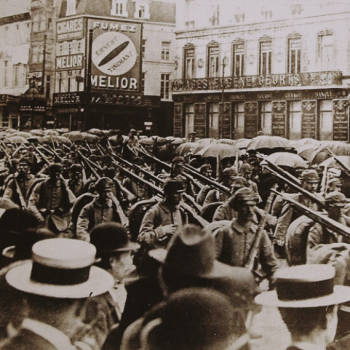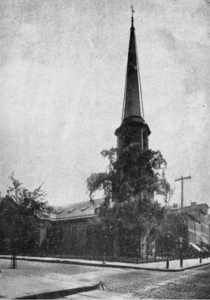
Church of the Holy Apostles.[1]
On January 17, 1899, Ernest and Aimée were married in the Church of the Holy Apostles in New York’s Hell’s Kitchen. Ernest told Reverend Brady E. Backus, who performed the rite, that “doubtless most of his friends would be greatly surprised that he should be married in a church, but that he had been brought up in the English Church and preferred to be married in its form.” It was reported that Emil was to have given Aimée away, but true to his word, he refused to attend the wedding. Minnie told Backus that Emil “was detained in Canada.” Fred Neresheimer was the best man, and his fiancé, Gertrude Annis, was the maid of honor. Aimee, “a singularly beautiful girl,” wore a simple “fawn-colored traveling dress and a velvet hat, both trimmed with sable fur. It was a quiet affair, with just about 15 people present in total. Following the ceremony, the wedding party had a celebrity dinner at the Hotel Manhattan. The following day, Ernest and Aimée set sail for England on board the S.S. St. Louis.”[2]

Sitting Room Of The Private Suite.[3]
It is probably not a coincidence that on the date of the Hargrove’s departure, John Pryse called for a Theosophical convention to be held in late April for the purpose of creating a new Society, or “organizing the remnant of the Judge division of the Theosophical society, which refused a year ago to follow Mrs. Tingley Into the Universal Brotherhood.”[4] Pryse’s letter revealed that many of the oldest workers had recently been expelled from the Universal Brotherhood without receiving official notification of trial, and that half a dozen of the headquarters’ staff, (many of whom served under W.Q. Judge,) had deserted Tingley’s faction.[5] Perhaps Pryse was holding out hope that Ernest would once again resume the office of the President or saw an opportunity to lead the Society himself with Ernest out of the picture. Whatever the case may be, Pryse’s group split from Tingley’s faction, and was unaffiliated with Dr. Buck’s Society (which never followed Tingley to begin with.)
Ernest was still very pressed for funds and had just enough money for the tickets on the boat for the two staterooms (one for Aimée and one for himself.) This was just for appearance, for the newlyweds consummated their marriage on board the ship. They arrived in Southampton, January 25, 1899, and stayed in London with Arch and Julia, who still resided at 62 Queen Anne. Ernest had a suite of rooms on the second floor, while Aimée had her room on the fourth floor. The situation was “very trying” at the Keightley home for Aimée because Ernest allegedly gave Arch and Julia the understanding that Aimée was not living with him as his wife.[6] “If I am Josephine,” Aimée would ask, “why must I be up on the fourth floor in a back bedroom?” But she would inevitably be charmed by Ernest’s “very marvelous personality,” and he would take her thoughts “into another channel, and build [her] very wonderful air castles so that [she] would be quite happy in the home for another day.”[7]
Not long after their arrival, an “extraordinary sensation,” occurred in New York with the publication of Rudyard Kipling’s poem, “The White Man’s Burden,” in McClure’s Magazine. The “burden,” Kipling asserted, “was the necessity laid upon Americans to civilize and uplift.” As the poem states: “Your new-caught sullen peoples, Half devil and half child.” The poem was quoted everywhere and was regarded as “the strongest argument yet published in favor of expansion, and a trumpet call to Americans not to recreant to their Anglo-Saxon birthright.” The work was lauded as “one of truth and soberness,” and as “sound politically” as it was “morally righteous,” with its claims of “the higher races to dominate the world are only so far justified as they accept and carry out this principle.”[8]
This was a sentiment that Ernest could not support. “We lose sight of the fact that one of the white man’s duties is to mind his own business,” Ernest would say. “This, domineering interference, even when absolutely necessary, should be considered regrettable. Perhaps the Anglo-Saxon has too much of the reforming spirit.” Huxley, whom Ernest preferred over Kipling in matters of social theory, had spoken of a “universal scheme of evolution” divided into two categories, the cosmic process, and the social process. Humanity could not evolve by adhering to the cosmic process of “survival of the fittest” in their social state, according to Huxley. They could only evolve by participating in the ethical process of development, “the line of least resistance and the best means of growth.” Humans had to become social beings, or else they would ”be left in this great race of progress.” What was true for the individual, Ernest believed, was also true of a nation. Clinging to the “cosmic process,” resulted in the downfall of past empires. It would be true for the British if they pursued a war with the Boers, and it would be true for the United States, should they follow in their parent nation’s footsteps. Empires which believed that “strength, and brute strength alone, would always give them victory,” always overlooked the profound and vital truth, that “once the social state is entered, then in order to survive, then in order to progress, it is necessary to become social, ethical, human.[9]
Aimée states that while at the Keightley home, Julia mentioned that she considered Ernest her “Mind-born son.” There is no further elaboration on her part as to what this statement may have meant. The “mind-born,” or Manasaputra, in the Theosophical conception, (as understood by the Griscom T.S.,) was the Higher Ego.[10] This understanding would certainly be in sympathy with the E.S.T.’s Aids and Suggestions No. 8 issued on March 1, 1899. The document commented on the Blavatsky’s statement that no Master would come, nor send a messenger , from December 31, 1899, until after December 31, 1975. Aids and Suggestions No. 8 further states that “the members themselves must govern the School as there is to be no leader,” and “the Outer Head is to remain absolutely unknown to the members of the School.” The Outer Head writes:
H.P.B. left in her writings the entire mass of the Lower Mysteries with the Instructions for a key. To understand this requires training (1) by living the life, (2) by linking with the Higher Mind (the fire of Kundalini playing on the pineal gland) and by (3) registering on the brain the knowledge thus acquired.[11]
World Politics was “consumed in the United States.”[12] Henry C. Potter, noted Episcopal Bishop of New York, stated in the April 1899 issue of The North American Review that it was a “remarkable” and “singularly original” work, and it expressed thoughts that he “wished had sprung from his own brain.”[13] Life on the marital plane was a different matter. Aimee was miserable, and Ernest was “piqued,” according to Aimee, that their destiny had yet to reveal itself.[14] Ernest, eventually, finished The Recovery of Health. The work closes with the following lines:
Wise are they who trust the idea of the universe and the vast recuperative power of nature, and who humbly elect to works on with her towards the restoration of balance which she, the great mother, is always willing to restore, that balance which alone enables mind to be sovereign over body.[15]
Ernest became inspired, once more, when the Hague Peace Conference in Holland was announced. This must have seemed like a revelation for Ernest, who believed in true universal brotherhood, and the “interchange between nations of the best and strongest influences they respectively possess.”[16] Ernest, Arch, and Aimée arrived in Holland in May to attend the Conference. Arriving at the same time were Felix Moscheles, and the journalist W.T. Stead, two men also in the Theosophical orbit.[17] (Stead, in fact, had just come from Russia where visited Blavatsky’s cousin, Sergei Witte.)[18]

Felix Moschele (left) & W.T. Stead (right.)[19]
On May 17, 1899, Aids and Suggestions No. 9, was dispatched. The subject of the document pertained to “Initiations.” It said that the E.S.T.’s first initiatory test occurred with the attacks on Blavatsky. The second initiatory was “as a psychic body, in the psychic world.” The School, the document stated, had, as a whole, passed through its third Initiation. The School itself was “an accepted Chela, of the Masters, and has its proper place and share in the creative work of the Oversoul,” meaning the School had taken its first steps into the “causal world.” Individual members who could realize themselves in the causal plane were now able to actualize three powers. “1. The power to guide his or her own life. 2. The power to draw forth the creative and the divine to become real and immortal selves, self-poised amid infinities. [and] 3. The omniscience and omnipotence of the Eternal.”[20]
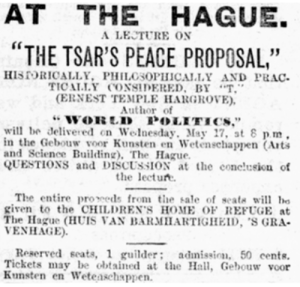
At The Hague.[21]
On that same day (May 17) Ernest gave a lecture titled “The Czars Peace Proposal” (the entire proceeds of which were donated to the “House of Mercy”) in which he mined the substance of World Politics and advocated for Boer independence and peace tribunals.[22] After the lecture, the delegates from Turkey (Turkhan Pasha, Noury Bey, Abdullah Pasha, Mehemed Pasha, Youssouf Bey, Aghiah Bey, Djavid Bey, and Sherif Bey,) approached Ernest, and one of them presented him with a copy of the addresses and memorial prepared by William Martin Jones (on behalf of the New York State Bar Association,) and strongly advised him to read it.[23] On July 9, 1899, Ernest gave a lecture, “The Next International Development,” in the foyer of the Diligentia Hall. Arch Keightley was also there.[24] Ernest stated:
It is one thing to establish laws for the regulation of war, and another thing to establish laws for the maintenance of peace: There are nations prepared for the maintenance of peace […] I believe that, among other nations. Great Britain and her Colonics, the United States of America, Holland, Norway, Sweden, and Denmark, are ready, or will very soon be ready, to enact laws for this government of international relations, establish permanent courts, and to mutually guarantee the enforcement of the decisions of those courts. I believe that this is the next international development, and that the whole course of international evolution leads up to it. [25]
Arch supported Ernest’s views In the discussion which followed. “The only question at issue here,” said Arch, “is the question of justice. It does not matter whether or not the Boers or the Uitlanders have been suppressed—the question is whether England is, now, acting justly. The time has come to submit the question of arbitration before the world. Justice must be done, irrespective of time or circumstance.”[26]
Ernest, sensing an impending conflict in South Africa, met with the State Secretary of the South African Republic, Dr. Willem Johannes Leyds, who was then living in Brussels. Leyds, a former professor at The Hague, was born in the Dutch colony of Java. A handsome man in his mid-thirties, Leyds was “slim and erect, with black, glossy hair, and large dreamy eyes,” who could hold engaging conversations in at least six different languages. Paul Kruger met him when he came to Holland in 1883, and subsequently hired him as his personal secretary. Leyds returned to South Africa with Kruger, and “quickly made himself master of the difficult South Africa problem.” Leyds was ultimately sent to Europe as an ambassador, where he represented Transvaal in the Seven Courts. Many were puzzled how this stranger from Holland acquired the power he did. Even the strong-willed Paul Kruger “was strangely influenced and ruled by his State Secretary,” for Leyds seemed to have “certain mesmeric powers,” over the Transvaal president.[27] Perhaps the best description of Leyds was a character sketch by the journalist Poultney Bigelow:
[Leyds] struck me as a man of another world, doing his daily work here faithfully but without pleasure. His conversation is that of a speculative philosopher, without human passions…One cannot conceive of Dr. Leyds ever showing temper or haste. He deals with the problem of humanity, though himself without the feelings of a man. I felt his intellect, his logic, his self-restraint, his exquisite capacity for veiling his meaning in polite phrases. He is, I am sure, enormously misunderstood—for he is credited with hatred of England, and passionate love of Dutch ascendency. This all is the absurdity arising from judging others as we judge ourselves. Leyds has no hate and no love…He deals with forces that affect humanity, and does not bother his head about a man more or less.[28]
Sometime around September 1899 Ernest “persuaded [Leyds] to give him a certain amount of money so that [they] could go out to South Africa and stop the Boer War.” Aimée states. “He was very happy, because these lectures at The Hague were very unsatisfactory to attract particular attention, and he said, ‘Well I am again fulfilling my destiny, now maybe we will really get started on fulfilling our destiny.’”[29] As we do not know the exact details of Ernest’s deal with Leyds, we might look toward the Irish-Australian journalist, Arthur Lynch, whom Ernest would rendezvous with in Pretoria once in South Africa, and who was also on Leyds’ payroll. Lynch’s cover was that he was traveling to Transvaal with journalistic commissions from Black-and-White, Collier’s Weekly and Le Petit Journal. In reality, J. Pierson, the Boer Consul General in Paris, had paid him 500 francs to cover his expenses.[30] (Both Arthur Lynch and Maud Gonne were agents for Leyds. They were also both connected to Charles Johnston and W.B. Yeats at various times. It is possible that Ernest’s introduction to Leyds lies somewhere in this ensemble.)[31]
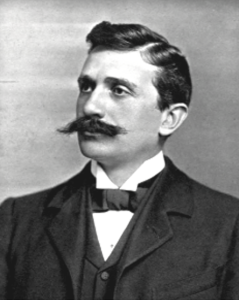
Dr. Willem Johannes Leyds.[32]
HARGROVE
I. “Refined English Atmosphere.”
II. “The Purple Mother.”
III. “Kitty Tingley, Despot.”
IV. “Villa Maria.”
V. “Dr. Leyds And The Occultation Of World Politics.”
VI. “The South African Situation.”
VII. “The Conciliator Of South Africa.”
VIII. “Transvaal Vs. Churchill.”
IX. “The Séances Of Thomas Welton Stanford.”
X. “The White Stag.”
XI. “The Hair Line Of Duty.”
SOURCES:
[1] Edelblute, Lucius A. The History Of The Church Of The Holy Apostles 1844-1944. Church Of The Holy Apostles. New York, New York. (1949): Front Matter.
[2] “Hargrove-Neresheimer” The Times Union. (Brooklyn, New York) January 18, 1899; “Ernest Hargrove Married.” The Sun. (New York, New York) January 18, 1899; “A Peculiar Marriage.” The Ottawa Journal. (Ottawa, Canada) January 20, 1899; “Theosophist Hargrove Weds.” The Kansas City Times. (Kansas City, Missouri) January 23, 1899; “Mr. Hargrove, Theosophist, Weds Miss Neresheimer!” The Nashville Banner. (Nashville, Tennessee) January 28, 1899; “Theosophical Marriage.” The Standard Union. (Brooklyn, New York) November 21, 1899; Edelblute, Lucius A. The History Of The Church Of The Holy Apostles 1844-1944. Church Of The Holy Apostles. New York, New York. (1949): 117.
[3] International Navigation Company. American Line/Red Star Line: Facts For Travelers. International Navigation Company. New York, New York (1895): 21.
[4] “Call For Convention.“ The Inter-Ocean. (Chicago, Illinois) January 28, 1899.
[5] The letter stated: “Avoiding the pitfalls of the past, the new society should be conducted on lines of strict sincerity and free from all mock secrecy and pretenses to occult learning. We are none of us occultists; let us honestly say so. There must be no leaders, but only a body of companions, sincere coworkers in the one great cause the spiritual welfare of the race.” [“Cuttings And Comments.“ The Theosophist. Vol. XX, No. 6 (March 1899): 380-384.]
[6] Aimée states: “I was too young, and he was simply taking me and molding my soul, as it were. I had no tutors or music teachers, and things of that sort. Of course, Mr. Hargrove would have to wait until they had all retired. Of course, I felt miserable under the circumstances because he sort of inflamed my imagination so much.” [In the Matter of Proving the Last Will and Testament of Ernest Hargrove.]
[7] In the Matter of Proving the Last Will and Testament of Ernest Hargrove.
[8] “Mr. Rudyard Kipling’s New Poem.” Lloyds Weekly Newspaper. (London, England) February 5, 1899; “The White Man’s Burden.” The Guardian. (London, England) February 8, 1899.
[9] “World’s Wars A Bar To Progress” The Philadelphia Inquirer. (Philadelphia, Pennsylvania) December 31, 1900; Hargrove, Ernest Temple “The White Man’s Burden,” in Addresses Delivered Before the Club During The Three Seasons, 1900-1903. Hausauer, Son & Jones, Printers. Buffalo, New York, (1904): 59-88.
[10] Charles Johnston provides an allegorical interpretation of Manasaputra in his commentary of the Chandogya Upanishad (V.3-10: A King Initiate): “Those who, in the forest, that is, in the life of discipleship, worship Faith and Truth, representing the principle called Buddhi, rise from the fire in a vesture of the color of the sun, and ascend through the succession of planes, in each gravitating to the positive pole. It is again a picture of Initiation. Then, when they have attained the spiritual world, spoken of as the realm of lightning, the Spiritual Man, the Mind-born son of Brahma, who is the Higher Self, causes them to enter the Eternal. For them, there is no return, the cycle of rebirth has been fulfilled. This, then, is the Path of the Gods, the Way of Liberation.” [C.J. “Chhandogya Upanishad: Part V. Sections 3-10: A King Initiate.” The Theosophical Quarterly. Vol. XXIII, No. 3. (January 1926): 218-226.]
[11] Cooper, John. “The Esoteric School Within the Hargrove Theosophical Society.” Theosophical History. Vol. IV, No. 6-7. (April 1993-July 1993):178-186.
[12] “Gedelegeerden Ter Conferentie” Net Vaderland. (Amsterdam, Holland) May 17, 1899.
[13] Potter, H. C. “National Bigness Or Greatness: Which?” The North American Review. Vol. CLXVIII, No. 509 (April 1899): 433–444.
[14] In the Matter of Proving the Last Will and Testament of Ernest Hargrove.
[15] Keightley, Archibald. The Recovery Of Health: With A Chapter On The Salisbury Treatment. Henry J. Glaisher. London (1900): 211-212.
[16] “Mr. Ernest Temple Hargrove.” The Boston Evening Transcript. (Boston, Massachusetts) December 22, 1900.
[17] “[Blavatsky’s house was a] center of attraction and of thought, and one would meet at times almost every ‘notable’ of the London world, religious, political, or artistic. Felix Moscheles, Robert Browning, Whistler, and Alma Tadema were among those of my own especial friends whom I have seen at Mme. Blavatsky’s, and of course there were distinguished visitors from other countries almost without number.” “Mme. Blavatsky.” St. Louis Post-Dispatch. (St. Louis, Missouri) May 13, 1891, “Peace Congress Opens Tomorrow.” The New York Journal and Advertiser (New York, New York) May 17, 1899.
[18] Ford, Thomas K. “The Genesis of the First Hague Peace Conference.” Political Science Quarterly. Vol. LI, No. 3 (September 1936): 354–82.
[19] Stead, W.T. “Some Pages of a Busy Life.” The Review Of Reviews. Vol. XIX (January-June 1899): 537-543.
[20] Cooper, John. “The Esoteric School Within the Hargrove Theosophical Society.” Theosophical History. Vol. IV, No. 6-7. (April 1993-July 1993):178-186.
[21] “Announcements.” New York Herald—French Edition.(Paris, France) May 15, 1899.
[22] Ernest said: “As in civil society, many a little alleged injustice will have to be suffered by one nation as well as by another, but the abandonment of those comparative trifles will not be an insurmountable obstacle. The states of North America, once so bitter against one another, have now become the United States; we have in them a template for which the States of South Africa (who are very much inclined towards an African Union) to follow. If one considers every single nation as an individual in the world of peoples, just as every citizen is an individual in his country and among his people, then it is obvious that to the question: ‘how can the Peace Proposal be solved?’ the answer is by the agreement of all nations to submit their disputes among themselves to the arbitration of tribunals. Regardless of whether the delegates of the nations who will assemble here tomorrow are each individually convinced that the Peace Congress will lead to nothing, or whether they are well-founded hopes that Congress will be a great step in the right direction, and world peace will finally come, their discussions can do nothing but conducive to the great world peace. As soon as we realize that there must not only be a sense of independence for each nation, but also a sense of interdependence among nations, peace will be achieved.” [“Gedelegeerden Ter Conferentie” Net Vaderland. (Amsterdam, Holland) May 17, 1899; “Voordracht Over Het Vredesvoorstel Van Den Keizer Van Rusland.” Dagblad Van Zuidholland En’s Gravenhage. (Amsterdam, Holland) May 19, 1899; “Over Den Vrede.” Net Vaderland (Amsterdam, Holland) May 19, 1899.]
[23] “English Gentleman Talks Arbitration.” The Democrat And Chronicle. (Rochester, New York) November 8, 1900; New York State Bar Association. Proceedings Of The New York State Bar Association. The Argus Company. Albany, New York. Vol. XXIV. (January 15-16, 1901): 185-186; “W. Martin Jones.” The New York Templar. Vol. XXV, No. 7 (May 15, 1906): 5. [A memorial, in this case being “a statement of facts, especially as the basis of a petition”]; Scott, James Brown. The Proceedings Of The Hague Peace Conference. Oxford University Press. Oxford, England. (1920): 7.
[24] “The Next International Development, What It Must Be If The Future Springs From The Past.” Dagblad Van Zuidholland En’s Gravenhage (Amsterdam, Holland) July 10, 1899; “Vervolg Der Nieuwstijdingen.” De Courant (Amsterdam, Holland) July 11, 1899; “The Transvaal Crisis.” Dagblad Van Zuidholland En’s Gravenhage. (Amsterdam, Holland) July 12, 1899; “Ter Van De Transvaalsche Crisis.” Delftsche Courant. (Amsterdam, Holland) July 12, 1899.
[25] “Transvaal Meeting.” Net Vaderland. (Amsterdam, Holland) July 12, 1899.
[26] “Transvaal Meeting.” Net Vaderland. (Amsterdam, Holland) July 12, 1899.
[27] “Europe And The Boers.” Leslie’s Weekly Illustrated. Vol. XC, No. 2329 (April 21, 1900): 306; “Dr. Leyds: Real And Imaginary.” The Review Of Reviews. Vol. XXIII (April 21, 1901): 458; Cumberland, Stuart C. People I Have Read. C. Arthur Pearson. London, England. (1905): 118-120.
[28] Bigelow, Poultney. White Man’s Africa. Harper & Brothers. New York, New York. (1898): 301-304.
[29] Stead, William T. “Shall We Let Hell Loose In South Africa?” The Review Of Reviews. Vol. XX (July-December, 1899): 355-361.
In the Matter of Proving the Last Will and Testament of Ernest Hargrove As a Will of Real and Personal Property; Appellate Division of the Supreme Court of New York, First Department Jun 27, 1941; 28 N.Y.S.2d 571 (N.Y. App. Div. 1941)
Great Britain, Parliament, House of Common. (1900). South Africa. Further Correspondence Relating to Affairs in South Africa. Presented to both Houses of Parliament by Command of Her Majesty. July 1900. In Papers by Command (Vol. 56). London, UK: H.M. Stationery Office: 127.
[30] McCracken, Daniel P. “From Paris To Paris Via Pretoria: Arthur Lynch At War.” Études Irlandaises. Vol. XXVIII, No. 1 (2003): 121-142.
[31] “Yeats, Charles Johnston, Vera Johnston, and Lynch were together on November 9, 1891. [Kelly, John S. A W.B. Yeats Chronology. Palgrave Macmillan. London, England. (2003): 23.] The story of Gonne and Leyds can be found in MacBride. [Maud Gonne. A Servant Of The Queen: Reminiscences. Victor Gollancz. London, England. (1938): 303-305.]
[32] Amery, L.S. “ The Times History Of The War In South Africa, 1899-1902: Vol. I. Sampson Low, Marston And Company. London, England. (1900): 235.


